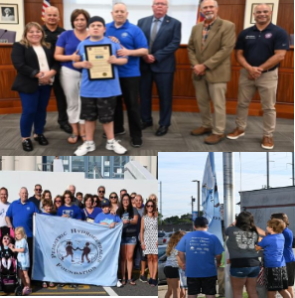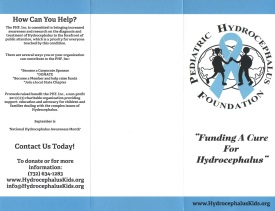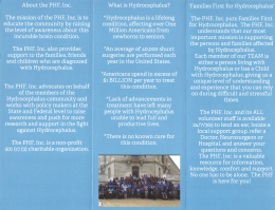Rootstown girl part of national campaign as the face of a rare disorder
April 18, 2012 by PHF Filed under Uncategorized
A Rootstown girl is representing the nation as the face of a rare disorder affecting more than 1 million Americans.
Mackenzie Holcomb, 11, a sixth-grader at Rootstown Middle School, will serve as this year’s “National Face of Hydrocephalus Awareness” for the Pediatric Hydrocephalus Foundation.
In the months ahead, she will be featured in advertising campaigns and promotional materials leading to National Hydrocephalus Awareness Month in September.
Mackenzie is representing the girls, while 2-year-old Jaden Brown of Colorado will represent the boys.
How does it feel to represent thousands of girls in the United States?
“It feels … good?” said the shy girl recently at her home in Rootstown.
Hydrocephalus, which means “water on the brain,” can be present at birth or can develop later as a result of infections, injury, trauma, or tumors of the central nervous system. In infants, the disorders can cause the “soft spot” of the skull to bulge and make the head larger than normal. Without treatment, many people with the disorder will die, but those who survive more than a year can have a normal life span.
Mackenzie’s mom, Amy Gyure said neither she nor Mackenzie’s dad, Gary Holcomb, noticed anything unusual about their daughter until July of 2008, when the girl’s hands started shaking. A local doctor diagnosed her with “intentional tremors” and referred her to Akron Children’s Hospital Medical Center. There, she was diagnosed with hydrocephalus as well as two benign tumors known as gliomas.
One of those, the one on the brain stem, was causing the fluid buildup. The other, which sits on the optical nerve, may have something to do with Mackenzie’s mild vision problems that require her to wear glasses.
The disorder has caused no developmental delays for Mackenzie, and her head has not swollen the way an infant’s head would. She has regular MRI’s to check on the tumors, and the hope is that the testing can become less frequent as she grows. She also gets yearly eye checkups.
She’s had six surgeries in the nearly four years since her diagnosis, most of them related to the shunt in her brain that drains the excessive fluid. The scars from those surgeries are covered by her shoulder-length black hair, and she has no symptoms most of the time. That is the biggest problem, her mom said.
“The hardest part is that she doesn’t show any symptoms,” Gyure said. “Before, I could count the number of times she’d been sick. Now she’s got a handful of doctors and surgeries left and right.”
Though she has no restrictions on her activities, her parents still have to watch for signs of a problem with the shunt, such as headaches and nausea. Her parents worry that an errant ball in gym class or a fall at school can lead to problems with the shunt. But it doesn’t keep her from playing sports, although Mackenzie is more of a spectator than a player.
But it has landed her in the hospital a few times. It’s an experience she sleeps right through, though she wakes up confused and, her dad says, always ready to eat.
In the months ahead, the foundation will collect photos of Mackenzie and interview her for various promotional pieces, all aimed at getting the attention of the federal government. The shunt was invented in the 1960s, decades before Mackenzie was born.
“They’re trying to get funding for research,” Gyure said. “The research is so outdated.”
Gyure said many parents of kids with hydrocephalus were given a grim prognosis, but now say they are blessed with happy children with a good quality of life.
“There’s not a lot of awareness,” she said.
 Read more at: https://html.com/attributes/img-width/>
Read more at: https://html.com/attributes/img-width/>



























Comments?